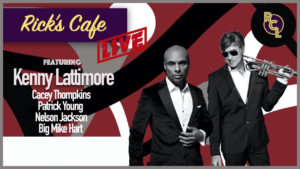Music Shows in a Post-Pandemic World
 By Katherine Gilraine
By Katherine Gilraine
At this time two years ago, in 2019, we hardly could’ve anticipated the turns of life that the Covid-19 pandemic would bring us. Of course, few could have anticipated the financial impact of the pandemic like musicians, promoters, and venues involved in the production of jazz shows.
There is hardly a need to remind people of what the world had gone through as a whole from March 2020 forward. The most crucial thing, however, that bears repeating is that nearly every person on this earth turned to the arts as a means of getting through what was happening around them.
One of the best features of contemporary jazz is the loyalty of its following. It is the one genre of this earth where, once a person gets a taste of what it really is, they generally don’t look back. It is a genre and a sound, varying from one artist to the next of course, that doesn’t fail to make one say, “Where has this been in my life, and how did I do without it?” This is especially true of how everyone coped with the pandemic: they turned to the artists – and the artists delivered.
 Already, the world has been progressing to an increasingly more virtual way of life for the last two decades; it was a matter of time until streamed shows were introduced to the public vernacular. As it were, the pandemic proved to be the catalyst in which this came to pass. Brian Culbertson took us into his studio on The Hang regularly, and Rick Braun’s Rick’s Cafe Live had quickly become a staple of pandemic living for most jazz fans. Boney James, Dave Koz, and Mindi Abair joined in on the fun as well. Other artists followed suit, and Innervision Records created an entire virtual festival.
Already, the world has been progressing to an increasingly more virtual way of life for the last two decades; it was a matter of time until streamed shows were introduced to the public vernacular. As it were, the pandemic proved to be the catalyst in which this came to pass. Brian Culbertson took us into his studio on The Hang regularly, and Rick Braun’s Rick’s Cafe Live had quickly become a staple of pandemic living for most jazz fans. Boney James, Dave Koz, and Mindi Abair joined in on the fun as well. Other artists followed suit, and Innervision Records created an entire virtual festival.
Truly, apart from the shows overlapping in timing, the pandemic gave root to an entire virtual jazz festival. Until vaccinations, this was probably the best way that everyone who could be relied upon to travel for a show could support their artists and gets their fill of music. Just like when Facebook proved to be the genre’s sustenance in the 2007-2009 radio shift, Facebook Live’s concert options were how jazz survived and thrived in the pandemic environment.
The problem, of course, is that there is truly no substitute for live music, nor could there be. There is a certain energy, something in the very air of a live show, that echoes in the soul and brings one back to life on a level that few other experiences can come near.
This is the same energy that is drawing the audience back to the major fests. However, smaller venues are facing a challenge, wrought in no small part by both the pandemic aftermath and the financial changes.
The landscape of life as we know it has been changed by this pandemic, in many ways irreversibly. One of the ways that it has done so it was that it mad people think twice before they make any plans to be in a public setting. Concerts, especially jazz concerts, are full of people, and while we didn’t mind this before, in the context of a global pandemic that had taken hundreds of thousands of people, the idea of a jazz show is enough to make people look askance.
This is something that many local event promoters are facing now. They want to see people in seats at shows, but how can they win over the recalcitrance of those who are not yet ready to re-emerge into the live music scene?
Many productions took the step of making their events vaccinated-only, which is, scientifically, the best possible route for both entrenching attendee and performer safety. Reminiscent of the polio vaccination drive, this proved to be a great motivating revival for major events, and in many instances, the patrons take it upon themselves to not wear masks in a vax-only setting, which only restores the feeling at the event that things are as they should be.
In addition to this, there are shifts in the economic landscape of the events, which shows namely in the price points for tickets.
It wasn’t unusual for us to see an artist in a smaller venue – Blues Alley, Scullers, Blue Note et al – for anywhere from $30 to $60 per ticket, depending on artist, seat, and holiday schedule, if any such applies. Major festivals, due to the higher cost associated with production, will naturally price their events higher, and most of the time, we were glad to pay the price for the value of the shoes and the experience.
This time, we are seeing these ticket prices right about doubled.
Before people begin saying “See, this is why people might not come out!” – not incorrect; price is a determining factor of attendance – there are certain things that must be pointed out. Namely, the first one is that from March 2020 until vaccines became available in early 2021, musicians had to survive without a scrap of income. We are talking about a year, more than a year even, of the people whom we only think of in the terms of their performance, going without any revenue whatsoever.
Let’s pause and remember that the people whom we love to see on stage, who are lauded for their talent that they share with us as openly as they do, are people. And, like everyone else, they have to figure out a way to pay their bills. What happens when your best revenue stream suddenly goes dry because of a global pandemic? We all know that stream income doesn’t cut it. We also know that the merch sales don’t cut it as bill-paying income on its own either. Showtime is how music – and musicians! – survive, and right now, as the music world across the genres dusts itself off, reassesses the damage, and gets back into the new post-pandemic normal, the people within it have to recoup 16-18 months’ worth of financial losses. This is the other part of the higher cost of attendance, and to be frank, considering how much of the arts we need, it’s the least we can do.
Once we put this into context, it becomes that much more important to attend events, if for the very simple reason that this is the best route we have in order to keep the genre going. Pandemic-related recalcitrance is understandable, but ultimately, the more people are out and in the seats and attending the events, the more likely the promoter is to see the increase in revenue, which in turn flows back to the artist. Music and the arts respond to us, the audience, every bit as much as we respond to what we see and hear; in the true form of supply-and-demand, the more demand for the music that we love, the more likely we are to get an increased supply in the forms of artists willing to tour, perform, and produce.
Certainly, after a year-long shutdown and pandemic, the least we can do is turn to the arts. It is the most essential and human thing to do.
